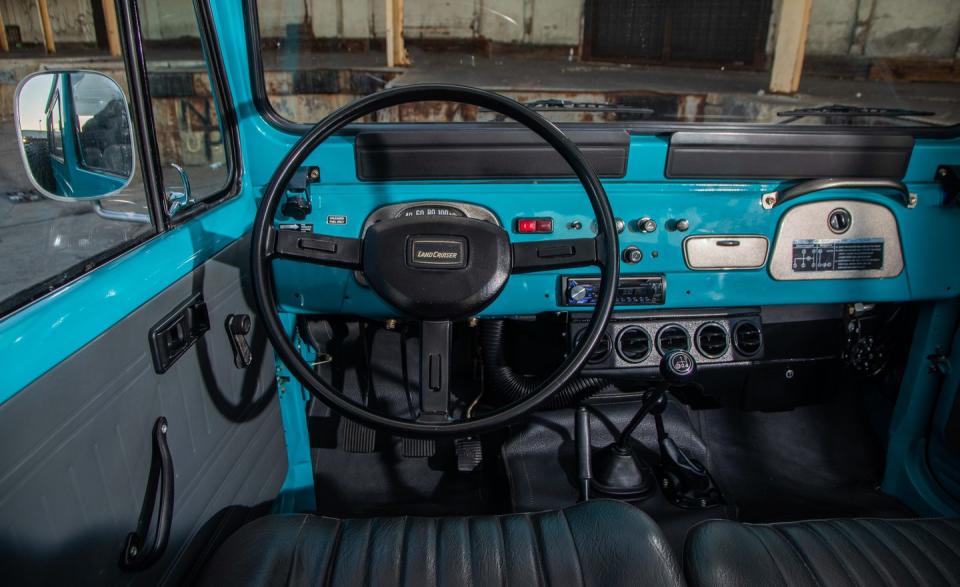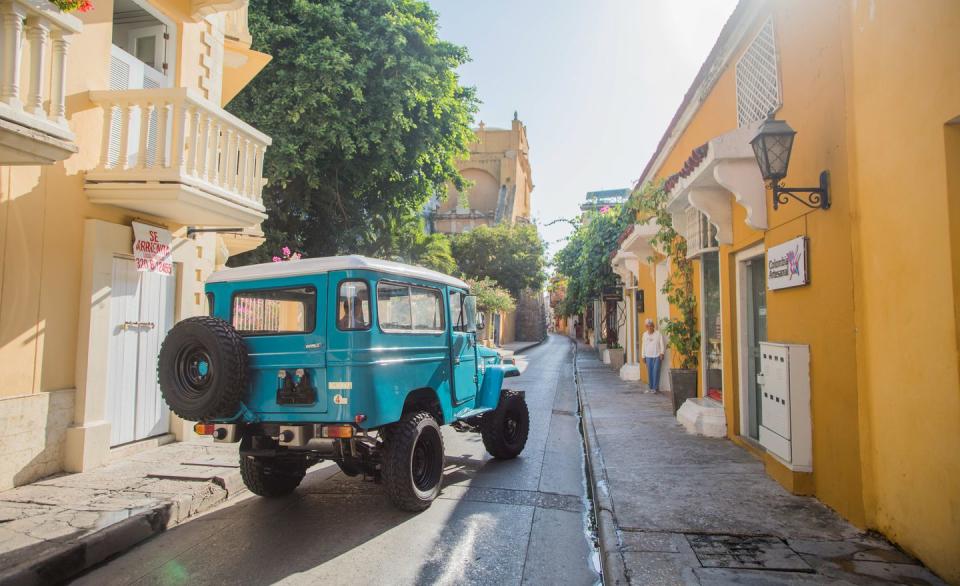Restored 1982 Toyota Land Cruiser Imported from Colombia

Take a gander at our "How to buy a vintage Land Cruiser" primer, and you quickly get the idea that importing a classic FJ from overseas is no easy task. Being the gluttons for punishment that we are, though, we thought we’d tag along as one buyer underwent the process.
Knowing the horror stories associated with importing a truck solo, our buyer was determined to use a middleman. Problem was, he didn’t exactly have the $120K-plus needed to guarantee a top-shelf restoration. He quickly found himself getting familiar with the Toyota Land Cruiser forum Ih8mud.com, looking at the offerings of various fledgling vendors. Though plenty of FJs made their way to South America (and many were even made there), it’s not easy to find companies offering this sort of turnkey package. Of the small group, only one, Land Cruiser Heaven, had a location nearby. We went to the owner’s home in early July 2016 to check out a recently completed FJ43. Assuming that the truck was likely indicative of the quality he’d receive, a build sheet was worked out, and the process began.
For a hair under $33,500, the buyer would have an FJ43 (that’s the mid-length, which was never offered in the U.S.) with a frame-off restoration, painted in Toyota’s awesome period Sky Blue with a Vintage Air climate-control kit, a stereo with Bluetooth, and an Old Man Emu (OME) 2-inch lift kit, all to be delivered in three to five months. Even if a few things were screwy, it was a small fraction of the asking price of pro-level restorers, and more than anything, we are suckers for a deal.
But it’s hard to keep an eye on what’s happening in Colombia. Pay $150,000, and your truck will be built by the company you’re paying. Cut a check for $34,000, though, and your truck might get done, but it’s anyone’s guess as to how, by whom, or when. In this case, it meant a subcontracted vendor outside of Cartagena would be paid by Land Cruiser Heaven-and it turned out that the vendor changes truck by truck, so really, the sample truck we drove in the U.S. offered no preview of what would actually show up.
As the subcontractor updated Land Cruiser Heaven, it in turn updated the buyer. Photos started coming in, showing the source truck being delivered, taken apart, sandblasted, painted, put together. Sure, this was all happening outdoors, but why pay attention to pesky red flags when you’re getting such a deal? The hope was to have it by the winter holidays-that gave Land Cruiser Heaven six months to make good on the upper end of its three-to-five-month promise. As the date drew nearer, though, it became clear that a winter arrival wasn’t going to happen at all. The updates started slowing as the buyer’s requests for photos became more frequent. He was told in early December that it’d be done in January, which came and went and the reality of the situation started to sink in.
In addition to wanting to document the delivery of a Land Cruiser, we were trying to time a trip to Colombia to photograph the completed truck in its native land. It was late February when that finally happened, and we slotted four days in Cartagena to shoot. On day one we were three-up in the front seat of a flatbed FJ70 work truck, headed about an hour out of town. I hung my elbow out the window and learned local jokes about donkeys as we dodged dogs and traffic to get to the tiny town of Turbaco. There, the FJ43 was literally being pieced together in the backyard of a house that looked as if it could use some piecing together, too. We wondered whether the Land Cruiser would be together in time to shoot, sure, but the bigger concern was the general state of affairs.
For one, the truck had pretty clearly been painted in a backyard. I didn’t have a paint thickness gauge on hand, but judging from the areas where the paint had already abraded through, this was pretty clearly not the “three coats of PPG paint and three coats of clearcoat” the buyer expected. Rubber seals had been roughly painted over, and big things-like the doors-just weren’t straight, fitting poorly enough against the body to cause the aforementioned abrasion. Door latches on the body side were installed crooked to compensate, screws stripped to match. The replacement glass in those doors had been hand-cut and wasn’t straight either-rolled all the way up, the windows didn’t seal. Other areas, like the window frames, had visibly dripping black paint. It wasn’t clear whether rust repair had been done prior to painting. Critically, the exposed stainless fastening hardware all around the body already showed rust beneath.
These are old trucks that didn’t leave the factory as straight as arrows, so maybe it’s okay that this one wasn’t perfectly straight 35 years on. Even less so was the locally sourced fiberglass hardtop, which used wavy plastic in place of Toyota corner glass. Myriad small things were missing, too-little rubber bushings to protect the fenders from the impact of the steel hood stays, for example.
On the other hand, both the frame and the running gear looked good-the project was pretty clearly being built on a good foundation, and things seemed to have been put together correctly. The frame had been sandblasted and painted black, and axles, brakes, hubs, and other big bits were painted black, too. Some engine parts and the transmission had been sprayed silver, and various steel hardware had been zinc-treated before reinstallation. Any mechanical issues could theoretically be cleared up stateside anyway, like the bizarrely long and meandering brake lines or the resprayed old radiator masquerading as new. Incredibly, the motley crew in Turbaco was able to get the FJ running with just enough time to shoot on day four. It wasn’t ready to be delivered, but it could be photographed.
After we got back, the buyer checked in regularly, and the delays continued. Finally, on March 18, news came that the truck would be ready to ship by the end of the month. By this point, too many truths had found new flexibility for hopes to be high. March came and went; April and May, too. Just before the truck would arrive stateside in June-nearly a full year later-the customer was told he’d need to buy new wheels and tires-the offset of the existing wheels no longer cleared the front disc brakes. Shame on him for not reading the fine print, but he’d been assuming that the restored truck would-you know-roll. Change that total to $35,101.
The good news about the truck’s arrival was quickly snubbed out by even more delays as a fantastic summer for Land Cruising passed by. The main culprit was that Land Cruiser Heaven was having a tough time subcontracting the installation of the Vintage Air heating/air conditioning kit. The buyer negotiated the price of installation out, but then LCH went dark, not responding to texts. Months later-in the middle of August-LCH called to say they’d found someone to install the kit. The truck was delivered on September 29, some 15 months after ordering.
Maybe by this point you’re picking up on the pattern. The truck was drivable, but plagued with electrical gremlins and more serious issues, like, for instance, doors that frequently unlatched while driving, so it had to go right back. Other items just weren’t worth following up on-either for fear of how long they’d take to fix or if they could be fixed stateside at all.
Our findings can be summed quickly and perhaps predictably: There might be a way to have your cake and eat it, too, for around $35,000, but we didn’t find it. The old adage about free lunch applies at least as much in this process as anywhere-you can pay $35,000 or $200,000 to get a restored Land Cruiser from South America. But if it doesn’t hurt in the wallet, it hurts in the timeline and in build quality.
At the time of this writing, the truck sits atop a trailer at LCH, awaiting another set of repairs. The enthusiasm the buyer had for the old truck back in the summer of 2016 has flatlined. It would be nice to have, but we’d wager it’d be even nicer to have the two years, $35,000, and the time and money it’s going to cost to make the truck right. With all that said, our intrepid buyer is certain that the issues can be corrected in time-it’ll take money, he says, but it’s not likely to cost the six figures that the pros would have demanded from the get-green. And perfect or not, any FJ43 is an awesome classic truck-and this one’s got good bones.
('You Might Also Like',)

 Yahoo Autos
Yahoo Autos 



